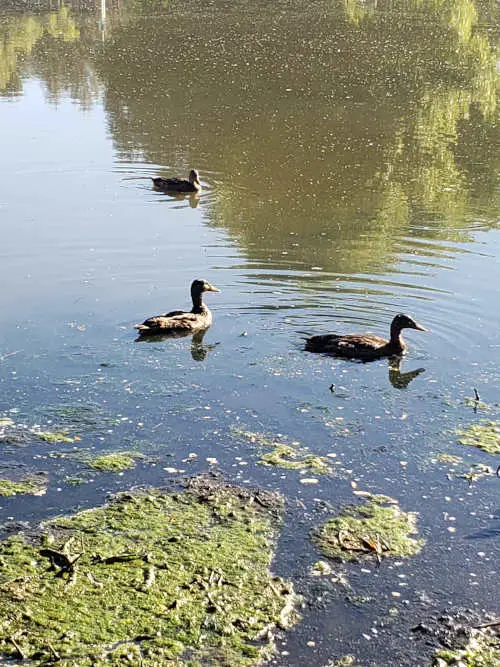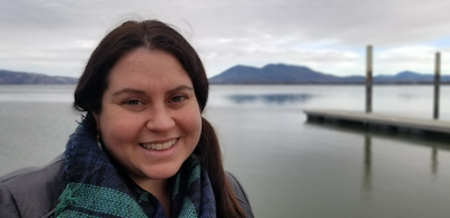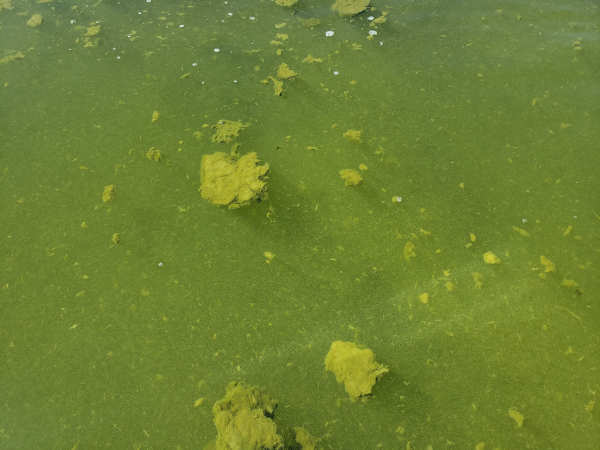
Editor’s note: This week we’re pleased to debut a new informational column on the health of Clear Lake. The new “Lady of the Lake” column is written by Angela De Palma-Dow, a scientist, certified limnologist and staffer at Lake County Water Resources (It should be noted, she’s writing these columns on her own time, not county time, and the views expressed are her own). Her goal is to answer questions from community members about Clear Lake. Email her at This email address is being protected from spambots. You need JavaScript enabled to view it..
Dear Lady of the Lake,
We have a family property on the lake in Soda Bay and the water in the lake there is really gross, it’s weedy, it smells, and I have heard that the algae growing on the top is toxic? We have children and dogs. What is going on and what do we do?
— Concerned in Soda Bay
Dear Concerned,
Thank you for asking this question, I am glad you are paying attention to the lake and you are noticing that the conditions have changed.
What you are seeing happens in the hot, summer months and sometimes into fall in many places around Clear Lake. There are three things you are seeing in the water that can contribute to the picture you described.
One: aquatic plants (or macrophytes) grow in the water, some are rooted in the lake sediments at the bottom and some are not rooted, and are free-floating.
Two: Green algae are microscopic plants (sometimes called phytoplankton) that are the primary fish food in the lake. Clear Lake is very green — that is from the green algae and that is why we have a world class fishery and people come from all over to catch record-sized fish in the lake.
Three: Cyanobacteria, sometimes called blue-green algae, but it’s not really an algae, is a bacteria that lives in the water and sometimes can look and act just like green algae.
Cyanobacteria is NOT a preferred food source for fish. Sometimes when cyanobacteria populations grow in great numbers (called blooms) they can produce toxins that can cause public health hazards, traditionally referred to as harmful algal blooms, or HABs.
All three of these things you might be seeing need three main things to live and reproduce. They need light, warm temperatures and food — from nutrients in the water.
During the summer the days are longer, so there is plenty of light throughout any given day. Macrophytes, algae and cyanobacteria all conduct photosynthesis, meaning they turn sunlight energy and carbon in the air into both oxygen and food energy or starch to grow.
Also during the summer, the air and water temperatures can be very, very warm (right now as I write this, the evening temperature is 97 degrees Fahrenheit — so pretty warm).
Lastly, all plants need some type of nutrition or food to fuel basic metabolic processes like growing and reproducing.
For macrophytes, algae and cyanobacteria, the three main nutrients they rely on for growth are carbon, nitrogen and phosphorus. Carbon and nitrogen are very abundant in the atmosphere and water, carbon in the form of CO2 and nitrogen in the form of N2 (gas) and any animal or plant waste or breakdown product in the water.

Phosphorus is least common, therefore phosphorus is the main driver of growth, because it’s normally least available, so it’s what limits growth of macrophytes, algae and cyanobacteria.
Now, in your bay, you are seeing what we call “the perfect storm.” There is abundant light, warm temperature and plentiful food nutrients.
During the summer phosphorus is most abundant in the water column compared with the rest of the year.
Normally phosphorus is bound in the sediments at the bottom of the lake, but during the spring and summer months, the lake is really active. Animals dig in the sediment bottom, winds mix up the sediments into the water column, and people even boat around and stir up sediments and shorelines through wave action.
Also, rooted macrophytes will absorb phosphorus from the sediment into their tissues through their roots and stems.
All this activity has effectively moved phosphorus into the water column where it is eaten by green algae and cyanobacteria.
As the temperatures get warmer and the days longer, more and more growth of macrophytes, green algae and cyanobacteria occurs and as the algae and cyanobacteria in the water column die, there are new cells waiting to eat the nutrients they released before it settles back into the sediment.
You are seeing this feedback loop of very productive growth happening in your bay. The conditions of this “perfect storm” are just right to promote growth of all three of these things, and will probably continue until something happens to break the cycle, like we get a really strong cold wind that prevents the growth of the algae and cyanobacteria (but can also stir up new nutrients from the bottom) or we get cold air and water temperatures or we received a large amount of rain to dilute the water.
If you are thinking that this list of things are unlikely in the summer in Lake County, you are probably right, especially as we head into another heat wave and continue this drought.
The smell you are noticing is from the dying of the macrophytes at the surface of the water where it’s really hot, and the matting and dying of the cyanobacteria.
Once the plants and cyanobacteria cells die, they eventually do get reabsorbed and recycled into the rest of the lake — but a majority of their mass goes to feed the next generation of cyanobacteria and green algae, and the cycle repeats itself. All summer long.
What can you do? Unfortunately, not much. I know you don’t want to hear that, but there really isn’t anything anyone can do to stop the process or stop the growth of algae or cyanobacteria.
This process is literally mother nature perfection — these organisms have been on the earth for millions of years, and in Clear Lake for hundreds of thousands.
People cannot control the light or water temperature, and while local and state agencies are working to remediate or reduce the amount of phosphorus and nitrogen in the lake, this process takes years and years and is very expensive.

There is nothing currently “chemically” approved that can be put in the lake that would safely “fix” the problem, no matter what Youtube claims.
There are short-term band-aid solutions, like watering down the algae mats, or breaking them up with a jet-ski or airboat, but those are all labor intensive and take gasoline energy and only provide a short-lived solution that might last a day. These types of activities also break up algae and cyanobacteria cells, releasing nutrients and feeding surrounding cells.
If there was a magic, effective solution, it would have already been in place and it would be used in lakes all over the country that suffer from this same situation like along Lake Erie and multiple lakes in Florida.
Stay safe! Even with all this, you and your family can stay safe. Make sure to monitor conditions of the lake, and any water body, before you go into the water. If the water looks like pea soup, is bright green, slimy or like paint, then stay out of the water.
Streams can also have cyanobacteria, but it can be growing in clumps or strands along the bottom, or benthic, portion of the stream.
For Clear Lake there is a comprehensive cyanobacteria monitoring program managed by Big Valley EPA and other tribal partners.
They have a website where they post their monitoring results on a map every two weeks — https://www.bvrancheria.com/clearlakecyanotoxins — and they post results on their Facebook page called “Clear Lake Water Quality.”
Red pins mean DANGER levels have been found and it’s recommended to not go into the water in that area. Orange pins mean WARNING, and yellow mean CAUTION. Green pins mean no cyanobacteria toxins have been detected in the sampled water from that area.
However, conditions can change daily in the summer, so use your judgement to keep you and your family safe.
Also know that public health trigger levels (caution, warning, danger) are based on adult human bodies and not children or pets, so even if there is a caution level (yellow pin) in an area where you wanted to go swimming, children and pets could be more sensitive and you should really think about looking for another location to enjoy the lake.
For pets especially, because they will unknowingly drink water while swimming and lick their fur when they get out of the water, be extra cautious and remember, when in doubt, just keep them out!
In case pets do go into the water, you should rinse or wash them down with clean, non-lake water as soon as possible.
It’s going to be a long, hot and sunny summer, it’s up to each of us to stay safe and recreate responsibly.
— Sincerely, the Lady of the Lake
Additional resources to help you learn about cyanobacteria, as well as green algae and macrophytes
County of Lake: http://www.lakecountyca.gov/Government/Directory/WaterResources/ClearLake/Cyanobacteria.htm
State HABs informational portal webpage: https://mywaterquality.ca.gov/habs/
Upcoming public learning opportunities about cyanobacteria include the Lake Board of Supervisors meeting on Tuesday, July 20, the Clearlake City Council meeting on Thursday, July 15 and the Lakeport City Council meeting on Tuesday, Aug. 3 (board and council meeting agenda items are subject to change, check relevant city and county websites for the most current information).
Angela De Palma-Dow is a limnologist (limnology = study of fresh inland waters) who lives and works in Lake County. She has a Masters of Science from Michigan State University. She is a Certified Lake Manager from the North American Lake Management Society, or NALMS, and she is the current president/chair of the California chapter of the Society for Freshwater Science. She can be reached at This email address is being protected from spambots. You need JavaScript enabled to view it..

 How to resolve AdBlock issue?
How to resolve AdBlock issue? 





